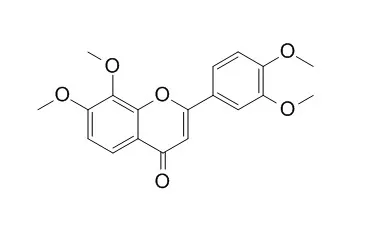| In vitro: |
| Korean Journal of Nutrition, 2009, 42(3). | | Composition of Flavonoids and Antioxidative Activity from Juice of Jeju Native Citrus Fruits during Maturation.[Reference: WebLink] | This study aims to evaluate the changes of flavonoid contents and antioxidants activity of Jeju native citrus fruits juice according to the harvest date.
METHODS AND RESULTS:
Flavonoids such as quercatagetin, narirutin, hesperidin and neohesperidin were contained most plentifully in the juice of Jigak (Citrus aur- antium) by 573.73 mg/100 mL, Sadoogam (C. pseudogulgul) by 393.99 mg/100 mL, Soyooja by 29.63 mg/100 mL and Jigak (C. aurantium) by 201.23 mg/100 mL in the late August, respectively. The highest contents of nob-iletin, sinensetin and tangeretin among polymethoxyflavones were found in the juice of Hongkyool (C. tachibana) by 7.39 mg/100 mL, 2.24 mg/100 mL, 0.63 mg/100 mL in the late August, respectively. 3,5,6,7,8,3',4'-Heptamet-hoxyflavone recorded the highest amount in Punkyool (C. tangerina) by 0.27 mg/100 mL in the late August, but the other polymethoxyflavones including 3',4',7,8-Tetramethoxyflavone, 3',4'-dimethoxyflavone, 4'-methoxyflavone, 5,6,7,3',4',5'-hexamethoxyflavone, scutellarein tetramethylether were observed only trace amount in all the citrus fruits. Flavonoid contents in the citrus fruit juices were the highest during early maturation and decreased rapidly while ripening. Total polyphenol contents were the highest in the late August and decreased with ripening. However from the late December, the contents were increased again. Antioxidant activities of the fruits were evaluated as electron donating ability and were the lowest in the late September and increased with the fruit ripening.
CONCLUSIONS:
These results suggest that quercetagetin among all the flavonoids was most plentiful in Jigak and Dangyooja (C. grandis), so that the fruits could be used for industrial material of flavonoids and antioxidant agents. |
|






 Cell. 2018 Jan 11;172(1-2):249-261.e12. doi: 10.1016/j.cell.2017.12.019.IF=36.216(2019)
Cell. 2018 Jan 11;172(1-2):249-261.e12. doi: 10.1016/j.cell.2017.12.019.IF=36.216(2019) Cell Metab. 2020 Mar 3;31(3):534-548.e5. doi: 10.1016/j.cmet.2020.01.002.IF=22.415(2019)
Cell Metab. 2020 Mar 3;31(3):534-548.e5. doi: 10.1016/j.cmet.2020.01.002.IF=22.415(2019) Mol Cell. 2017 Nov 16;68(4):673-685.e6. doi: 10.1016/j.molcel.2017.10.022.IF=14.548(2019)
Mol Cell. 2017 Nov 16;68(4):673-685.e6. doi: 10.1016/j.molcel.2017.10.022.IF=14.548(2019)